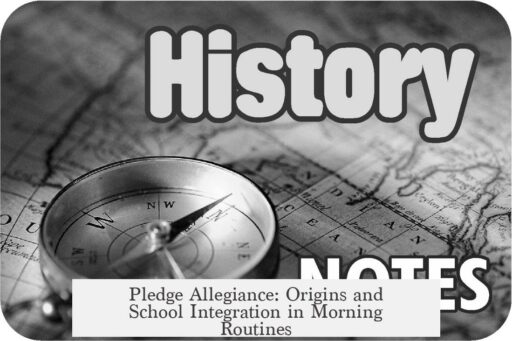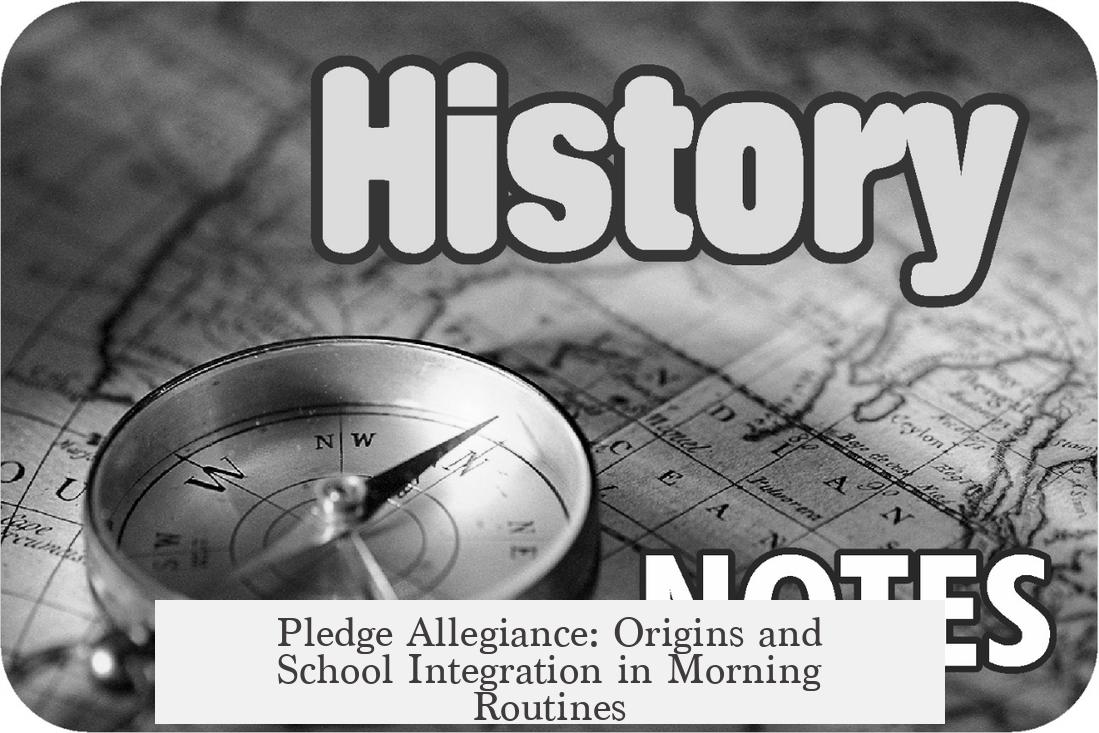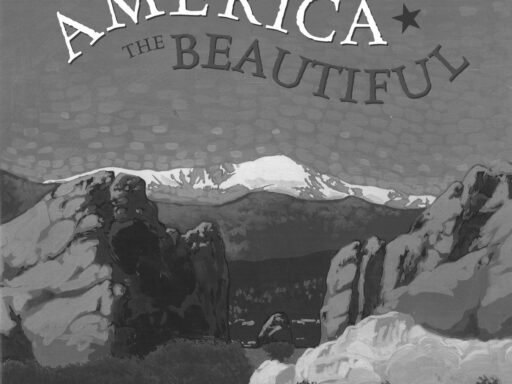The pledge of allegiance originated in 1892, created by Francis Bellamy with James Upham’s support for a nationwide school celebration marking the 400th anniversary of Columbus’ voyage. It was introduced as a patriotic exercise in schools and became part of morning routines very soon after, deeply rooted in educational and cultural contexts of the time.
The pledge was crafted at a time when American public education sought to unify diverse student populations through shared rituals. Its initial wording was simple: “I pledge allegiance to my Flag and the Republic for which it stands, one nation, indivisible, with liberty and justice for all.” The pledge’s debut was aligned with a major federal holiday on October 21, 1892, declared by President Benjamin Harrison, which schools across the nation observed.
The event carried a strong educational purpose—to foster a common sense of American identity among children, many of whom were immigrants or descendants of recent arrivals. Schools already emphasized routines and Americana, making this pledge a natural extension of existing practices. These routines were important in creating cohesion and patriotism in communities that were culturally diverse.
Public schooling in the late 1800s had evolved significantly. From the 1830s onward, the rise of common schools aimed to provide a unified educational experience for children of all social backgrounds. The educational content and daily routines were heavily influenced by Protestant traditions and American historical narratives. These practices included prayers and recitations, fostering a structured environment that helped integrate new patriotic elements like the pledge.
Bellamy’s pledge fit perfectly into this framework. The school day, already organized around shared experiences and rituals, incorporated this pledge to further bind children to the national ethos. Many editors and educators at the time supported the pledge, seeing it as a means to “baptize” immigrants culturally and reaffirm loyalty among native-born children.
By placing the pledge within daily school routines, educators effectively cemented it as a standard practice. Newspapers detailed how children should honor the flag and recite the pledge, underscoring its instructional role in schools. This daily repetition became a cornerstone of patriotic education across the United States.
Over time, the pledge underwent formal recognition and changes. Congress officially adopted it, and significant amendments occurred, notably the insertion of “under God” in 1954 during the Cold War era. This addition reinforced the ideological distinction between America and communist states, reflecting evolving social and political climates.
Though initially part of a single commemorative event in 1892, the pledge’s integration into school morning routines marked the beginning of a longstanding tradition. It blended seamlessly with other educational practices rooted in nationalism, religious influence, and a growing public school system designed to unite a diverse population.
| Aspect | Details |
|---|---|
| Creation Year | 1892 |
| Creators | Francis Bellamy & James Upham |
| Original Purpose | 400th anniversary of Columbus’ voyage |
| Initial Wording | “I pledge allegiance to my Flag and the Republic for which it stands…” |
| First Adoption Setting | National holiday, Oct 21, 1892 |
| Integration in Schools | Soon after 1892; part of daily routines |
| Influences | Protestantism, Americana, common schools |
| Formal Adoption & Amendments | Congress adopted pledge; “under God” added 1954 |
- The pledge began as a patriotic text for a major national event in 1892.
- Schools incorporated the pledge into daily routines to promote unity and American identity.
- Educational customs, shaped by Protestantism and Americana, made the pledge a natural addition.
- The pledge’s wording and ritual evolved, with formal congressional adoption coming later.
- The addition of “under God” in 1954 reflected geopolitical and cultural shifts.
Where Did the Pledge of Allegiance Come From and When Did It Start in Schools?
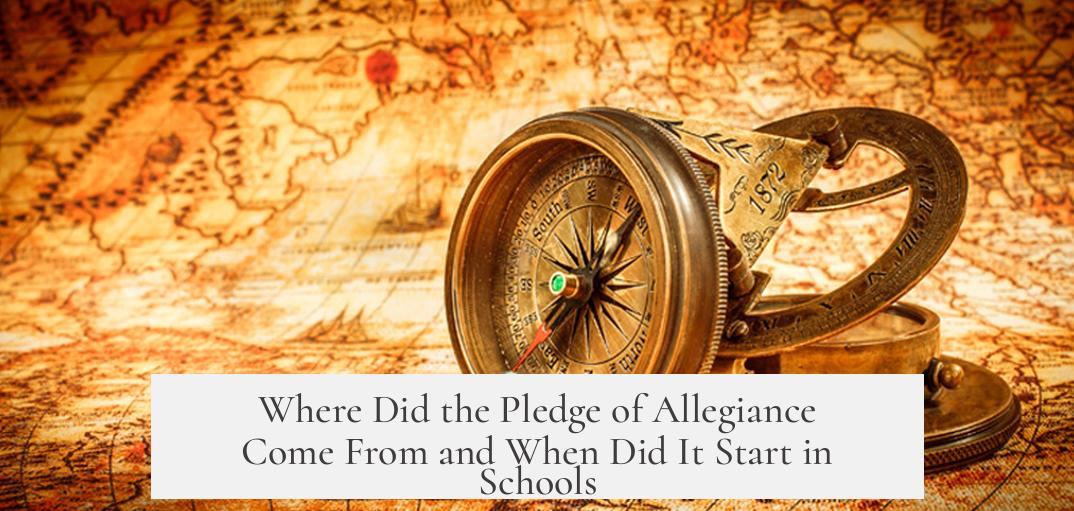
The Pledge of Allegiance began as a small patriotic poem written in 1892 by Francis Bellamy, specifically to be recited in schools during the 400th anniversary of Columbus’ voyage, and it quickly became a morning routine in American classrooms. But to truly grasp this snippet of American tradition, we have to rewind further, diving into the world of 19th-century education and cultural currents that shaped it.
Before the pledge stepped into the spotlight, the educational landscape in America was stirring a significant social experiment—the rise of common schools in the 1830s. These schools aimed to create a shared learning experience where children of all social classes, from wealthy landowners to hardworking craftsmen, sat together. The underlying goal? To prepare future citizens who could participate fully in democracy.
Seeds of Patriotism in the Classroom
Now, classrooms back then weren’t just places for reading and arithmetic. They were battlegrounds for cultural identity. Protestantism played a big role in shaping school routines—think daily prayers and weekly recitations borrowed from church traditions. Schools were places where routines became rituals, where Americana—an idealized version of American history and values—was skilfully served alongside math problems and spelling bees.
When waves of Catholic immigrants arrived during the late 1800s, they often chose private schools, partly to shield their children from these Protestant-infused public school routines. This highlights how education wasn’t only about academics; it was also about cultural assimilation.
The Birth of the Pledge of Allegiance: 1892
Fast forward to 1892: the year a nationwide celebration was brewing. The 400th anniversary of Columbus’ 1492 voyage was a massive deal. Newspapers, politicians, and educators rallied to plan commemorative events. Enter Francis Bellamy—a Baptist minister and author—who teamed up with James Upham, the editor of The Youth’s Companion, a popular children’s magazine.
Bellamy’s task was straightforward yet bold: create a simple pledge kids could memorize and recite during Columbus Day celebrations. The result was the original pledge, just two lines long:
“I pledge allegiance to my Flag and the Republic for which it stands, one nation, indivisible, with liberty and justice for all.”
This was no small gesture. President Benjamin Harrison even declared October 21, 1892, a national holiday to mark the anniversary, with a detailed schedule—highlighting the pledge recital as a key event. Newspapers echoed the call for all children to embrace the pledge, embedding it into the culture.
But why the pledge? The answer lies in education’s dual purpose: helping immigrants *become* Americans, and reminding those born here of their shared identity. Schools were now not simply places to learn reading and math but arenas of cultural baptism where patriotism was taught alongside phonics.
The Bellamy Salute: A Full-Body Act of Patriotism
The original routine was not just about words. Bellamy and Upham believed patriotism deserved more than a hand on the heart; it called for a full-body salute! Their instructions were precise:
“At a signal, pupils stood in ranks, hands at their sides, then lifted their right hands, palm downward, to forehead level. While reciting the pledge slowly, the right hand extended palm upward toward the flag during the words ‘to my Flag’ and held this gesture until the pledge ended.”
This dramatic gesture was meant to signal solemn respect and unity. However, history has another twist: this salute, later called the Bellamy Salute, was replaced in 1942 by the modern hand-over-heart gesture, partly because the original salute resembled the Nazi salute during World War II—definitely not the patriotic association anyone wanted.
From Columbus Day to Every School Day: The Pledge’s Integration Into Morning Routines
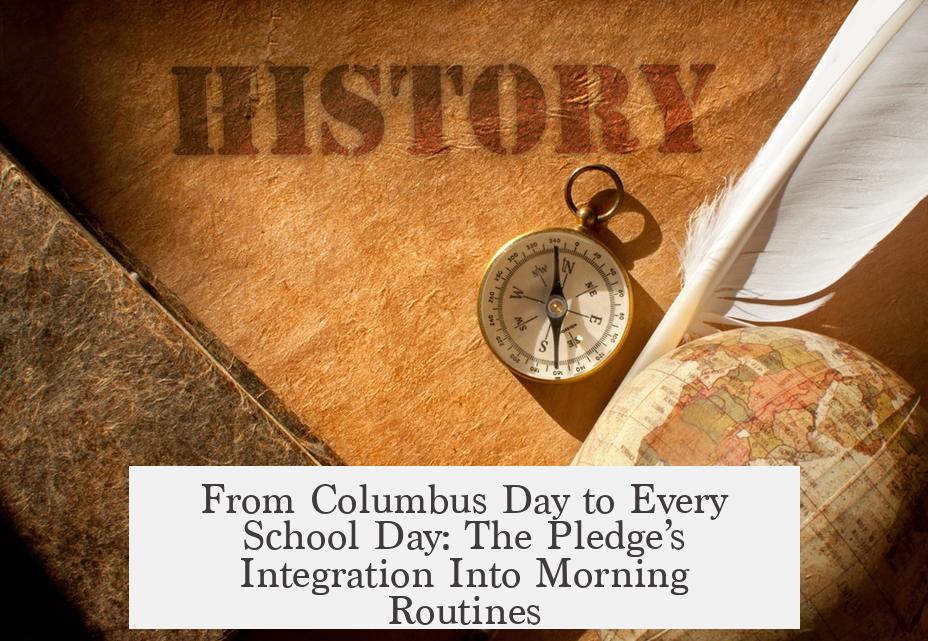
Following its 1892 debut, the pledge’s use swiftly expanded beyond Columbus Day celebrations. Schools began integrating it into daily routines. By the early 20th century, reciting the pledge during morning assemblies became a common part of classroom life.
This habit fit neatly with the established culture of daily rituals—prayers, recitations, and America-centered lessons. It helped enforce a homogeneous national identity and encouraged a sense of civic duty from a young age.
Formal Adoption and Changes Over Time
Congress officially adopted the pledge in 1942, cementing its role in public education. Over the years, it underwent changes to reflect the country’s shifting values and political climate.
The most famous amendment came in 1954 when the phrase “under God” was added. This insertion mirrored America’s Cold War tensions and was a direct response to the perceived threat of atheistic communism abroad. The government wanted to emphasize faith and nationalism hand-in-hand.
So, the pledge you hear today —
“I pledge allegiance to the Flag of the United States of America, and to the Republic for which it stands, one Nation under God, indivisible, with liberty and justice for all.”
— is quite different from the 1892 original, layered with historical context embedded in every word.
Why Does This History Matter Today?
Knowing where the pledge came from and why it became part of school routines gives us insight into American education, society, and values. It wasn’t just a catchy rhyme; it was designed as a tool to unify a diverse and expanding nation.
Imagine being a child in 1892, an immigrant or native-born, suddenly part of a collective ritual bonding you to a new identity. It’s a powerful example of how education serves not just to inform but to forge community.
Questions remain about its role in modern classrooms. Should daily recitations continue? What about students who opt out due to personal beliefs? The pledge’s history invites us to consider how patriotism, inclusivity, and freedom intersect in education.
Practical Tips for Educators and Parents Today
- Provide context: Teach children the origins and evolution of the pledge. A historical lens makes the ritual more meaningful.
- Respect choice: Allow room for discussion and respectful opt-out policies addressing diverse beliefs.
- Integrate Americana wisely: Balance patriotic teaching with critical thinking about history and values.
- Create space for inclusion: Recognize the pledge as part of tradition but not the sole way to express citizenship or belonging.
In Closing
The Pledge of Allegiance began as a carefully crafted poem to celebrate a milestone. It transformed, riding waves of common school reforms, Protestant influence, and nationalistic pride. It slowly wove itself into the fabric of everyday life in schools, becoming an educational ritual designed to shape American identity—one recitation at a time.
Next time you hear the pledge in a classroom or public event, remember that it is a living piece of history, its words echoing the hopes, challenges, and cultural battles of a nation constantly defining itself.
